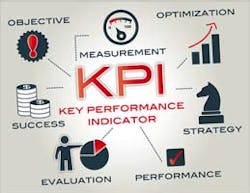8 myths about developing KPIs in your dental practice
KPIs encompass a critical part of managing the performance of your dental practice
Navigating uncertain terrain in business can be a daunting task, particularly if you don't have the proper tools to help. Just like a pilot needs instruments to keep them on course, so we also need the proper tools to keep us on course in business.Enter the KPI, or Key Performance Indicator—one small acronym that encompasses a critical part of managing the performance of your business. On the most basic level, a KPI serves to help you understand why your business is performing a certain way. The KPI does this by showing correlations that reveal growth and efficiency. With robust KPIs in place to help you understand the why, you'll be able to affect change by continuing what works well or altering the course when something is not working.
As business advisors, we have come across a variety of misconceptions regarding KPIs. The effect of these misunderstandings is that business owners can fall short in affecting real change in their company. Have you heard or believed any of these eight myths?
Myth #1: It's not necessary to develop a system for gathering and tracking KPIs.
Junk in = Junk out. Let's face it. There are all kinds of reports you could compile about any aspect of your business that wouldn't tell you anything significant. To have meaningful KPIs, you need to find the path of least resistance to gather information that is accurate and consistent every time. It's worth the time investment to set up your system or process correctly so that you're accurately gathering the data you need.
Speaking of your system or process—it needs be efficient to truly help you attain and produce a timely KPI report. If the data gathering process isn't efficient, you probably won't make the commitment to review, analyze, and take action on the information. Take the time to discover the path of least resistance to gather and track this data, so you can get the information you need.
Myth #2: It's not important to block out time to review KPIs.
As a business owner, you may face a seemingly endless onslaught of tasks, decisions, and fires on a daily basis. You may even be a primary producer in your business which makes your time management all the more critical for success. The growth-oriented philosophy articulated in E-Myth encourages business owners to work on your business, not in your business. While this may look like only a difference in wording, the concept is absolutely critical for growth.
As the primary leader, you must find a way to pull yourself out of the operational picture in order to consider the organizational picture. To stay on the operational plane is essentially to take the ostrich approach of burying your head in the sand. Like my dad taught me many years ago, if you put your head in the sand, you get a boot...well, you get the picture. For further insight, I would recommend E-Myth by Michael Gerber, or any of his additional industry-specific pieces.
Once you do make the decision to carve out time to work on your business, respect this time to focus on the business. Make sure you're intentional and remove distractions so that you can truly understand what the KPIs are telling you.
Myth #3: My business doesn't have or need KPIs.
Every business in every industry has KPIs. In other words, every business in every industry has something that drives it. The mindset I train each of our analysts to have is that each dollar of revenue comes from somewhere. Every dollar was billed and, most of the time, paid. But, what was it specifically that was billed and how did it get to a place where the business could bill it? These questions drive at the heart of what makes up a KPI.
Myth #4: KPIs are purely revenue indicators.
KPIs apply to both revenue and expenses; you'll hear most CPAs or CFAs refer to these as financial ratios. If you produce a product or provide a service, you have to develop the capacity to sell that product or service. With KPIs, we look at the expenses associated with that development, both financial (costs) and operational (utilization).
Myth #5: I should be able to understand KPI data immediately.
It takes time to see and understand correlations without relying on experts who have been there before. You want to avoid falling into data overload, so I would advise against pulling all of the KPIs and digging in without having a strategy first.
Once you're comfortable with the highest level of information, drill deeper into the financial picture by reviewing revenue/cost per customer, day, hour, square foot, patron, product line, service line, contract profitability, etc. When you're comfortable there, drill deeper into the operational picture by looking at hours/volume per customer, day, hour, square foot, patron, product line, service line, contract, equipment, etc. You'll want to keep alternating from financial to operational just like this in order to see the correlations in your business performance. Finally, you'll want to try combinations, like looking at revenue/cost per hour/volume to get the most detailed picture of what's going on.
Myth #6: Reviewing KPIs is the final step in impacting business performance.
The goal of reviewing KPIs should be to create action items to impact your business in the desired direction. Many business owners believe reviewing KPIs to be the final step because they don't know how to see the next step. It's easy to see that one month's performance may be up and the next it's down, but many business owners don't take the step to determine what they should do about it. It is critical to take the time to reflect upon the period's performance and understand any specific circumstances that might have caused the performance.
When you're developing KPIs, you'll develop from financial to operational. When you develop action items, you'll go in reverse—from operational to financial. The thinking behind this is that your operational changes will move the needle on the financial compass.
Myth #7: It's not important to educate staff members about implementation plans or action items.
Many business owners feel as though they must mandate their staff to change once action items are developed. On the contrary, I would argue that the best way to gain buy-in and greater commitment from your staff would be to educate your team regarding the implementation plans or actions items. Empower your staff to take charge and affect change by creating an environment where an awareness mentality is encouraged.
READ MORE:Financial Vitals—5 reasons dentists have a love-hate relationship with money
I've found that most people are good and want to do a good job. It's up to leadership to educate and empower their teams to help develop action items or the implementation plan. When your staff sees that their contributions are encouraged and valued, don't be surprised if you see greater employee ownership of what's produced.
Myth #8: If I don't see immediate results after making a change to my business, it means that there was no value in changing course.
Developing your business can be compared to cultivating a plant—even the best seeds take time to grow. Trust the system you've developed! You have to allow time for changes to take root and results to show. If you implement a new action item, you can't immediately change course the moment the KPIs don't report as positive.
A business is a living organism—and just like there's no magic pill to heal an illness or make you lose weight, you must allow some time for your action items to affect change. While you're being patient, continue to cultivate your business by monitoring and educating your team regarding progress.
It’s important to remember that you don’t have to navigate alone. We can help you along the journey—from building your statistical systems to analyzing and monitoring your progress—we are here to serve you. As a business owner of a growing enterprise, you seek advisors who don’t just sell you the next plan or product, but who white-board with you to uncover your remarkable and unique path to success. You can reach us at [email protected] or 972-881-1501.
READ MORE FROM CLOWER: How opening a dental practice is like cooking a steak
About the Author

Ryan Clower, CPA
Partner
Ryan Clower, CPA, is a partner at MWA CPAs + Advisors, a national accounting and advisory firm dedicated to serving leading dental practices, practice owners and dental service organizations. Clower specializes in practice management, financial accounting, practice performance optimization, practice valuation and practice acquisition and sales. Clower is a Certified Public Accountant. He graduated from the University of Texas at Dallas.
Updated April 12, 2016


